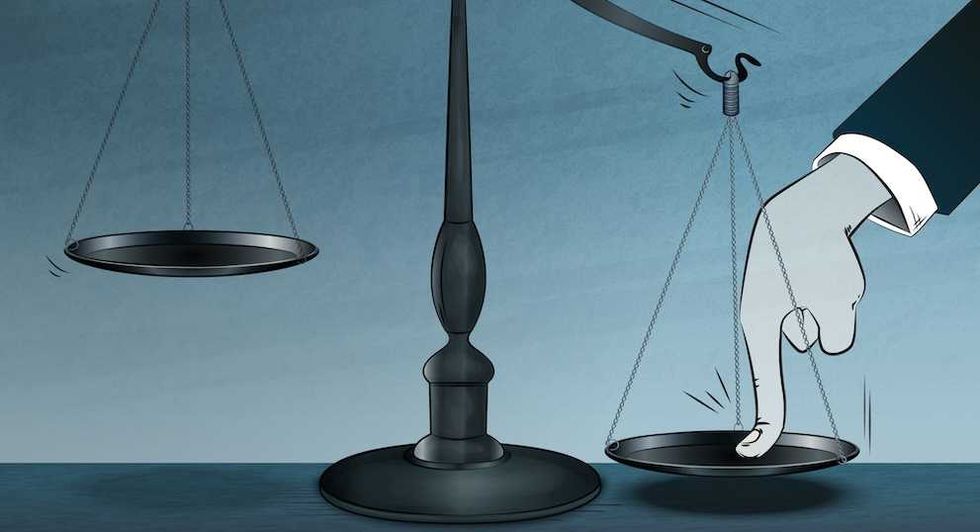One would think a federal judge trying to block the president from deploying the National Guard to protect federal agents would mark the breaking point for judicial supremacism. Yet the Trump administration still behaves as if the Supreme Court can rescue it from judicial overreach. It cannot. You can’t comply your way out of judicial tyranny, appoint your way past it, or count on the high court to stop it. The judiciary must be delegitimized completely.
Congress passed by overwhelming margins a law banning Chinese-owned TikTok in the United States. President Trump ignored it. He ordered Attorney General Pam Bondi to keep the app online, and no one in Washington blinked. The president defied a duly enacted law, extended TikTok’s life beyond the 90-day limit, and still allows just under 20% Chinese ownership. Yet the same Washington class insists that any judge can command the president on immigration, national security, or even his use of the National Guard — and that such rulings are the word of God.
The proper response is not to plead for Supreme Court review — it’s to ignore such rulings outright.
Late Saturday night, U.S. District Judge Karin Immergut, a Trump appointee, ruled that the president lacked authority to deploy the Oregon National Guard to Portland to protect ICE facilities. The same judiciary that called a few hours of chaos on Jan. 6, 2021, an “insurrection” now dismisses eight months of rioting, doxxing, and targeted attacks on ICE agents as “lawful protest.”
On Sunday, Immergut extended her injunction to every state’s National Guard units, even those like Texas, whose governors had granted Trump permission to federalize.
The merits of her decision aren’t the core issue. The problem is structural: Federal courts claim abstract standing to decide national-security questions that belong to elected branches. Judicial power was never meant to work this way.
If a citizen suffers injury, he can seek damages in court. But no judge has constitutional authority to referee political disputes as if she were deciding some sort of civil case between Microsoft and Amazon. The proper response is not to plead for Supreme Court review — it’s to ignore such rulings outright.
If the judiciary holds the final say in every political or constitutional conflict, checks and balances collapse. When judges alone define their own powers and the limits of the other branches, we cease to be a republic and become an unelected oligarchy. Abraham Lincoln, citing Thomas Jefferson, warned that once a free people submits absolutely to any department of government, liberty is lost.
When one branch violates the Constitution, the others — and the people — must push back. The founders never vested final authority in any single branch, least of all the one insulated from elections. Presidents come and go; judges remain for decades, accountable to no voter.
I don’t like that Trump sets tariff rates and hands out exemptions by executive order. He even granted Qatar de facto NATO protection without Senate approval. Those moves deserve political resistance — but not judicial vetoes. Questions of national policy belong to voters and legislators, not to courts hunting for imaginary plaintiffs.
Immergut granted standing to Oregon and Portland to challenge Trump’s finding of a “violent domestic insurrection,” claiming there were only four clashes with federal officers in the prior month. Even if that number were correct, no judge has the power to second-guess an executive’s determination of an uprising. Governments cannot sue one another over political facts. We are either a constitutional republic or a dictatorship of robes.
The founders understood this. James Madison originally proposed that the Supreme Court share a “council of revision” with the president to veto legislation. Once the Constitution created an independent executive with its own veto, no serious thinker imagined adding a judicial one. In 1789, Madison made clear that while courts interpret law in specific cases, no branch “draws from the Constitution greater powers than another in marking out the limits of the several departments.”
RELATED: Americans didn’t elect a Boston judge president
 Cemile Bingol via iStock/Getty Images
Cemile Bingol via iStock/Getty Images
When branches clash, each uses its own powers to persuade the public. Madison wrote that differences between the legislative and executive “may be an inconvenience not entirely to be avoided.” That friction, he said, reflects the “concurrent right to expound the Constitution.” In other words, conflict is not a crisis — it’s republican government at work.
Today’s judicial supremacy replaces that rough balance with North Korean-style obedience to unelected authority. What’s next? Will judges write the 2026 federal budget while the president and Senate argue?
Waiting for the Supreme Court to reverse rogue lower-court rulings is a fool’s errand. As Justice Samuel Alito warned in Trump v. CASA, class-action suits and nationwide injunctions make such limits meaningless. Even if the high court eventually reverses Immergut, the administration will have wasted precious time and capital — while worse precedents, like birthright citizenship rulings, remain untouched.
How far must this usurpation go before the executive reasserts its authority? Until the presidency and Congress together reject the judiciary’s false supremacy, the United States will remain trapped in a system unworthy of a free people.
The post Who checks the judges? No one — and that’s the problem. appeared first on TheBlaze.




